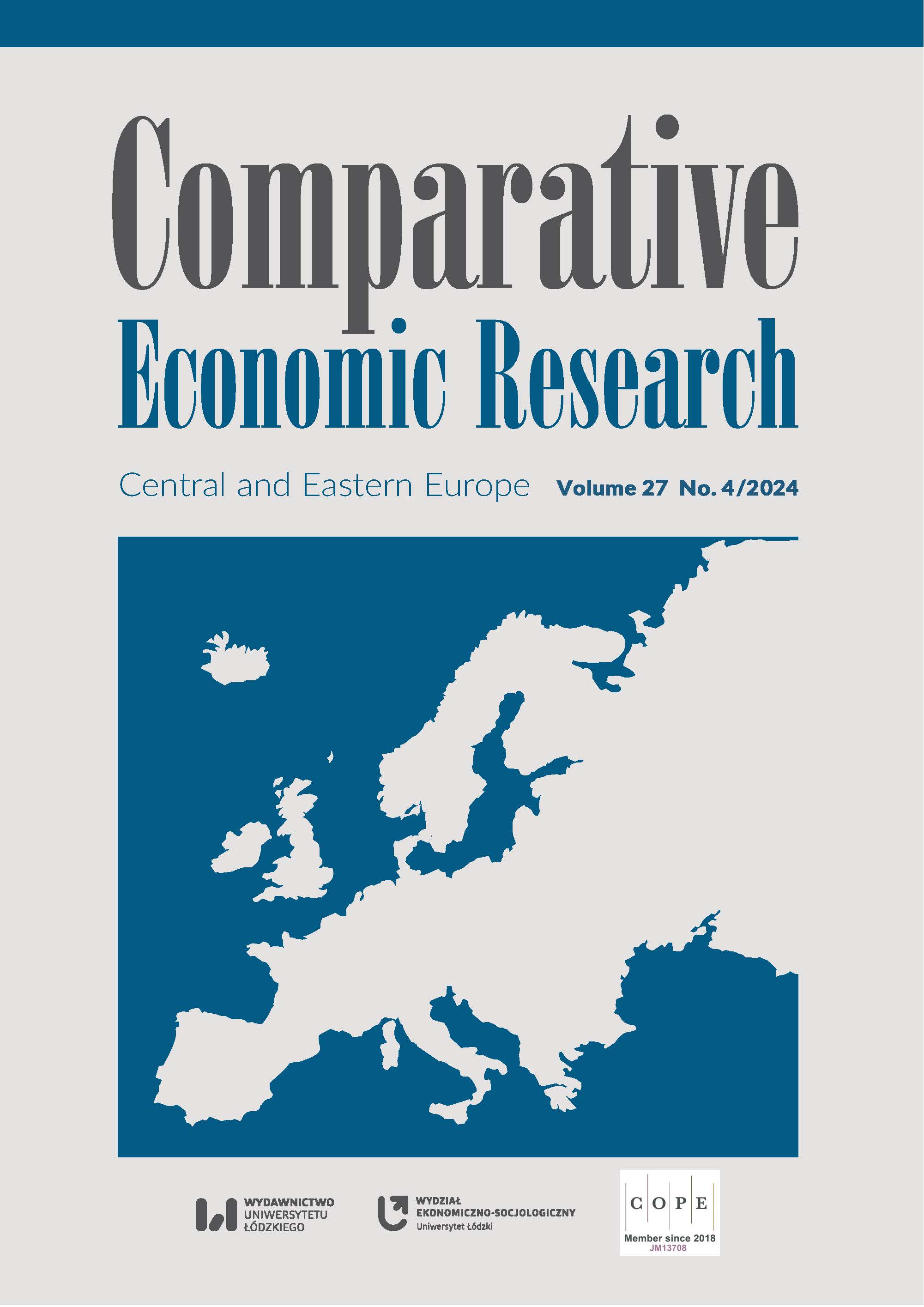Przeniesienie stóp procentowych i transmisja polityki pieniężnej w krajach SADC i EAC: implikacje dla unii walutowej
DOI:
https://doi.org/10.18778/1508-2008.27.34Słowa kluczowe:
przeniesienie stóp procentowych, integracja finansowa, unia walutowa, SADC, EACAbstrakt
Kraje Południowoafrykańskiej Wspólnoty Rozwoju (SADC) i Wspólnoty Wschodnioafrykańskiej (EAC) analizują możliwość ustanowienia unii walutowej. Niniejsze badanie poddaje ocenie proces integracji gospodarczej w obu blokach, wykorzystując mechanizm przenoszenia stóp procentowych w celu określenia konwergencji stóp procentowych w obu regionach. Wykorzystując dane miesięczne od stycznia 2000 r. do grudnia 2022 r., obejmujące stopy procentowe banku centralnego i banków detalicznych, niniejsze badanie ocenia możliwości stworzenia unii walutowej. Zastosowano ilościowe podejście badawcze z wykorzystaniem panelowego modelu autoregresyjnego o rozłożonych opóźnieniach (PARDL).
Wyniki uzyskane dzięki zastosowaniu dynamic common correlated effects (DCCE) sugerują, że w obu blokach nie występuje pełne przeniesienie stóp procentowych banku centralnego na stopy banków detalicznych. Po drugie istnieją różne prędkości dostosowań stóp bankowych w odpowiedzi na zmiany stóp procentowych banku centralnego. Ponadto niepełne przeniesienie stóp procentowych w obu blokach wskazuje na obecność niedoskonałości rynku bankowego, słabej jakości aktywów bankowych i asymetrii informacji, przy czym kwestie te są bardziej widoczne w EAC. Aby sprostać tym wyzwaniom, decydenci w obszarze polityki pieniężnej powinni wdrożyć środki mające na celu zwiększenie wydajności i konkurencyjności ich systemów finansowych w celu zminimalizowania tych niedoskonałości.
Pobrania
Bibliografia
Aydin, H.I. (2007), Interest Rate Pass‑Through in Turkey, “Working Paper”, 07/05, Research and Monetary Policy Department, The Central Bank of The Republic of Turkey, pp. 1–42, https://ideas.repec.org/p/tcb/wpaper/0705.html (accessed: 9.09.2023).
Google Scholar
Aziakpono, M., Kleimeier, S., Sander, H. (2012), Banking market integration in the SADC countries: Evidence from interest rate analyses, “Applied Economics”, 44 (29), pp. 385–386, https://doi.org/10.1080/00036846.2011.583219
Google Scholar
DOI: https://doi.org/10.1080/00036846.2011.583219
Chudik, A., Pesaran, M.H. (2015), Common correlated effects estimation of heterogeneous dynamic panel data models with weakly exogenous regressors, “Journal of Econometrics”, 188 (2), pp. 393–420, https://doi.org/10.1016/j.jeconom.2015.03.007
Google Scholar
DOI: https://doi.org/10.1016/j.jeconom.2015.03.007
Gigineishvili, N. (2011), Determinants of Interest Rate Pass‑Through: Do Macroeconomic Conditions and Financial Market Structure Matter?, “Working Paper”, WP/11/176, International Monetary Fund, pp. 1–19, https://www.elibrary.imf.org/view/journals/001/2011/176/article‑A001‑en.xml (accessed: 7.02.2023).
Google Scholar
DOI: https://doi.org/10.5089/9781462312313.001
Cottarelli, C., Kourelis, A. (1994), Financial structure, bank lending rates, and the transmission mechanism of monetary policy, “International Monetary Fund Economic Review”, 41, pp. 58–623, https://www.elibrary.imf.org/view/journals/001/1994/039/article‑A001‑en.xml (accessed: 7.02.2023).
Google Scholar
Henning, C.R. (1996), Europe’s Monetary Union and the United States, “Foreign Policy”, 102, pp. 83–100, https://doi.org/10.2307/1149261
Google Scholar
DOI: https://doi.org/10.2307/1149261
Hofmann, B. (2002), The pass‑through of money market rates to business loan rates in the euro area countries, Center for European Integration Studies (ZEI), University of Bonn, Bonn.
Google Scholar
Iris, B.‑F., Howells, P. (2002), Central Banks and Market Interest Rates, “Journal of Post Keynesian Economics”, 24 (4), pp. 569–585, https://doi.org/10.1080/01603477.2002.11490344
Google Scholar
DOI: https://doi.org/10.1080/01603477.2002.11490344
Jobarteh, M. (2023), EAC. Geographic Furutes, https://futures.issafrica.org/geographic/recs/eac/#cite‑this‑research (accessed: 9.09.2023).
Google Scholar
Li, X.L., Si, D.K., Ge, X. (2021), China’s interest rate pass‑through after the interest rate liberalization: Evidence from a nonlinear autoregressive distributed lag model, “International Review of Economics & Finance”, 73, pp. 257–274, https://doi.org/10.1016/j.iref.2020.12.031
Google Scholar
DOI: https://doi.org/10.1016/j.iref.2020.12.031
Liu, K. (2019), The determinants of China’s lending rates and interest rates pass‑through: A cointegration analysis, “Research in Economics”, 73 (1), pp. 66–71, https://doi.org/10.1016/j.rie.2019.02.002
Google Scholar
DOI: https://doi.org/10.1016/j.rie.2019.02.002
McCarthy, C. (2008), The Roadmap towards Monetary Union in Southern Africa – is the European experience commendable and replicable?, Third GARNET Annual Conference, Bordeaux, Panel IV –2: Monetary and Financial Governance, pp. 1–18, https://www.tralac.org/images/docs/4682/mccarthy‑roadmap‑towards‑monetary‑union‑in‑southern‑africa-20081022.pdf (accessed: 9.09.2023).
Google Scholar
Muzindutsi, P.F., Mposelwa, S. (2021), A Comparative Analysis of the Expectations Hypothesis of the Term Structure of Interest Rates between the BRICS and G7 Countries, “Comparative Economic Research. Central and Eastern Europe”, 24 (2), pp. 87–102, https://doi.org/10.18778/1508-2008.24.13
Google Scholar
DOI: https://doi.org/10.18778/1508-2008.24.13
Ndou, E., Mokoena, T. (2019), Does Economic Policy Uncertainty Impact the Pass‑Through of the Repo_rate to the Bank Lending Rates?, [in:] E. Ndou, T. Mokoena, Inequality, Output‑Inflation Trade‑Off and Economic Policy Uncertainty, Palgrave Macmillan, Cham, pp. 425–435, https://doi.org/10.1007/978-3-030-19803-9_30
Google Scholar
DOI: https://doi.org/10.1007/978-3-030-19803-9_30
Pesaran, M. (2007), A simple panel unit root test in the presence of cross‑section dependence, “Journal of Applied Economics”, 22 (2), pp. 265–312, https://doi.org/10.1002/jae.951
Google Scholar
DOI: https://doi.org/10.1002/jae.951
Redda, E.H. (2021), Convergence Criteria‑guided Regional Economic Integration in SADC and EAC: Lessons from Europe’s Experience, “Journal of African Union Studies”, 10 (3), pp. 39–65, https://doi.org/10.31920/2050-4306/2021/10n3a3
Google Scholar
DOI: https://doi.org/10.31920/2050-4306/2021/10n3a3
Sander, H., Kleimeier, S. (2006), Interest rate pass‐through in the common monetary area of the SACU countries, “South African Journal of Economics”, 74 (2), pp. 215–229, https://doi.org/10.1111/j.1813-6982.2006.00073.x
Google Scholar
DOI: https://doi.org/10.1111/j.1813-6982.2006.00073.x
Tai, P.N., Sek, S.K., Har, W.M. (2012), Interest Rate Pass‑Through and Monetary Transmission in Asia, “International Journal of Economics and Finance”, 4 (2), pp. 163–174, https://doi.org/10.5539/ijef.v4n2p163
Google Scholar
DOI: https://doi.org/10.5539/ijef.v4n2p163
Pobrania
Opublikowane
Jak cytować
Numer
Dział
Licencja

Utwór dostępny jest na licencji Creative Commons Uznanie autorstwa – Użycie niekomercyjne – Bez utworów zależnych 4.0 Międzynarodowe.











